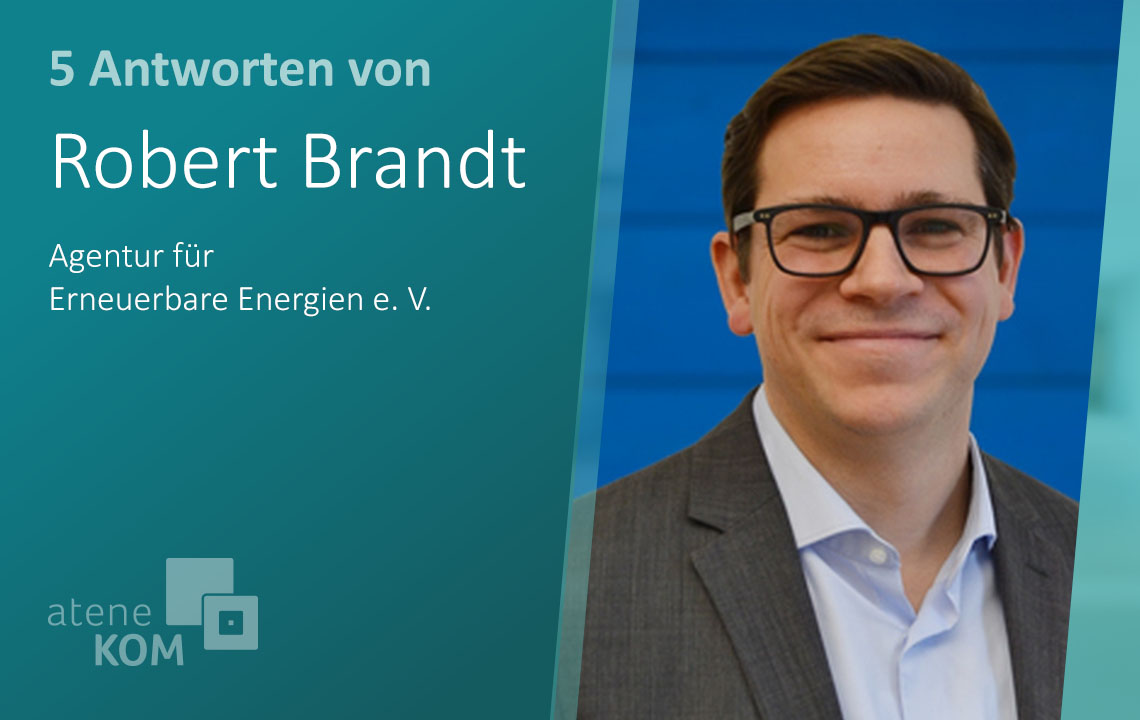Around 83,000 electric cars are on the road according to the Federal Motor Transport Authority are already on Germany’s roads – and the trend is rising. However, in order for the transport transition to make a noticeable contribution to achieving the climate targets set out in the Paris Agreement, the next step must be taken quickly: Electric vehicles should increasingly be charged with electricity from sustainable energy sources. By 2030, at least 30 percent renewable energy must be used in the transport sector, demands Robert Brandt, Managing Director of the Agency for Renewable Energies e.V.in an interview with aconium GmbH.
aconium: To what extent are renewable energies currently used in the transport sector in Germany?
Robert Brandt: Renewable energies currently account for around five percent of final energy consumption in the transport sector. This share is significantly lower than in the heating or even the electricity sector, where 40 percent of the electricity used already comes from renewable sources. In addition, the contribution from renewables in the transport sector has barely grown in recent years and consists mainly of biofuels. Although these are still needed, they cannot achieve the necessary decarbonization of transport on their own. The need for action in this area is immense. In addition to starting with fuel, there is also an urgent need for a change of drive in our vehicles. Electromobility must and can become a major component of future transportation, at least in the private car sector.
aconium: What share can renewable energy sources be expected to account for in transportation in 10 years?
Brandt: That depends on a great many factors and is therefore difficult to predict. Many factors play a role, from traffic development and the implementation of electric or even hydrogen mobility to the efficiency of the means of transportation. In a meta-analysis on the use of electricity in the transport sector, for example, we have shown how different the forecasts for energy consumption and carriers in transport are. However, one thing is clear: the current rate of transformation is nowhere near sufficient. For greenhouse gas development to be in line with the goals of the Paris Agreement, at least 30 percent renewable energies would have to be found in the transport sector by 2030, with further decarbonization all the faster thereafter. This can only be achieved if we adopt a clear perspective towards innovative solutions today, both in terms of drive technology and charging infrastructure.
aconium: What challenges will the energy sector have to deal with until then?
Brandt: First of all, it is crucial that the use of electricity for mobility purposes, whether directly, as hydrogen or as a synthetic fuel, becomes established. Experts refer to this as sector coupling. This electricity must then come from renewable energies. If electric mobility is used as an argument for longer running times for coal-fired power plants, nothing is gained. This also requires an ambitious expansion of solar and wind energy. Finally, it is also about the organization in the mobility sector itself: Which technology will prevail? Do we need new drive systems or new fuels? If we prioritize electromobility, which we believe makes the most sense for reasons of efficiency, how will we manage to set up the necessary charging infrastructure? What communication technologies are needed between the charging stations and the vehicles so that charging is controlled and does not place an excessive burden on our electricity grids? These are just some of the energy-related questions. Further transport debates such as “How much space do we give the car?” or “How can autonomous vehicles and public transport be reconciled?” have not even been considered.
aconium: What could solutions that overcome these challenges look like?
Brandt: Technologically, there are already many options: Electric vehicles are available on the market in various designs. What an intelligent charging infrastructure could look like or how synthetic fuels could be produced is already known in principle and could be expanded relatively quickly. There are still question marks over some business models, but our companies are certainly resourceful enough to develop suitable offers. The political framework conditions are a crucial prerequisite for all these developments to gain momentum. For example, most experts agree that a CO2 price would greatly help the transport transition and that no new vehicles should be allowed to use fossil fuels from 2030. In order for manufacturers and mobility service providers to be able to adapt to this, decisive implementation is required.
aconium: What is your wish for the energy supply of tomorrow?
Brandt: I have three wishes: 1. CO2 emissions, regardless of the sector, must have a clear price that comes as close as possible to the true cost of damage.
2. We need a continued ambitious expansion of renewable energies, especially in the electricity system, as this is increasingly becoming the primary energy source of our modern societies. Otherwise, the government’s target of 65% renewable energy by 2030 will be jeopardized.
3. The individual components of the energy system must be closely networked and react flexibly to one another. Virtual power plants, intelligent charging mechanisms, flexible use of biogas, smart grids – these are all key components for a sustainable, digital and innovative update of our energy supply.
Find out more about current and alternative drive systems for vehicles in the aconium GmbH series of publications on transport and the environment:

